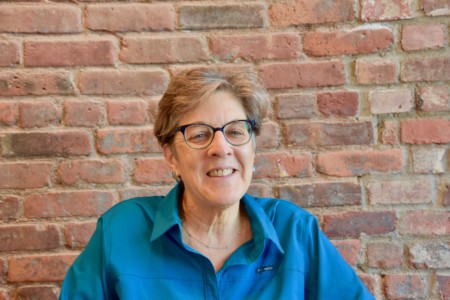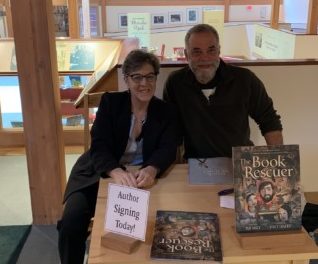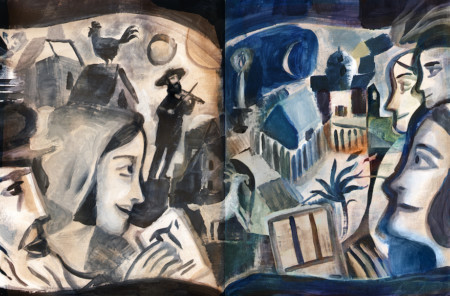Decades ago when I was raising four sons in suburban Chicago, I chose to pursue my first graduate degree at Spertus College. In addition to attending required classes, I worked with my thesis advisor, Elliot Lefkovitz to create a series of independent studies classes focusing on American Jewish women. I was determined to write about Jewish women who were left out of history books. The Jewish Women’s Archives published five of my essays.
I’m always happy to welcome children’s authors to this website who share women’s lives with their audiences. Today, Sue Macy answers questions about her background, her interest in writing about women, as well as some of her other writing projects. Even though her most recent book, The Book Rescuer, does not focus on a prominent woman, it shows how one person can make a difference. If you have yet to share this Sydney Taylor Gold Medal Award-Winning book with a child or a classroom, I recommend that it be added to your list for books to read in 2020.

At what point in your life did you recognize a passion for writing?
I was in fourth grade the first time I realized how empowering writing was for me. I had written a short story for school. When my teacher praised it, I felt like I had just won a gold medal at the Olympics.
Much of my early writing was for my school papers, and for my local newspaper when I worked as a summer intern. My first published books were word search books you used to find at supermarket checkout counters and a compilation of puzzles from Scholastic’s DynaMath Magazine. Humble beginnings, but they lit a fire in me to do more.
Your website mentions that your interest in Jewish women began during a student-initiated seminar in women’s studies. How many of your children’s books focus on women? Is there a common thread running through these stories?
Other than The Book Rescuer, all of my books either focus on women or, in the case of my Olympics books, feature women heavily. I am fascinated by the history I never learned when I was a kid, especially the stories of women’s accomplishments. Strong women were few and far between in the history books of my Baby Boomer generation. This shortcoming deprived young readers of role models and devalued women’s achievements. My message for kids and their parents is that women made history right alongside men. It’s important for girls and boys to know about it.
Can you elaborate further on your comment that your time at Scholastic Inc. was a “sort of finishing school for writers and editors, giving us hands-on experience that was more authentic than what we would have learned in graduate school.” What skills did you learn in this environment and can you identify three mentors?
First and foremost, my editors at Scholastic helped me develop my voice in writing for kids. I worked mostly on Scholastic’s classroom magazines. We were producing material every week. I learned numerous things:
- How to write leads that immediately grabbed the reader
- How to digest my research and use it to clearly explain complicated topics
- How to respect young readers and never write down to them.
I also learned how to listen to and respond to my editor’s comments—so basically, how to be a professional writer. And eventually, I learned how to be an editor and work with other writers to make their work better.
My first editor on the magazines, Carol Drisko, was responsible for many of these lessons. Scholastic’s founder, M.R. Robinson, was still there when I started. His approach to writing for children, as well as his work ethic, definitely had an impact on me. Lucy Evankow, the company’s irascible chief librarian, taught me a lot about photo research—which is very important in my books. She demonstrated how a woman can earn the respect of her bosses and colleagues while maintaining high standards and independence.
With such a diverse portfolio of published books, what is the main source of your ideas?
At this point, I pretty much always look at the world as a children’s nonfiction author. When I go to a lecture, or watch a documentary, or attend a Zoom event online, at some point I will ask myself whether something that’s being presented would make a good children’s book.
Are your manuscripts submitted directly to a publisher or do you use a literary agent?
I recently signed with a literary agent—Liza Voges, an agent at Eden Street. Prior to signing with Voges, I had another agent for two books years ago. Other than this instances, I’ve sold books directly to publishers. I was lucky to develop relationships with a few editors early on. I continued to work with them on several projects.
Approximately, what proportion of your time is spent researching, writing, editing a children’s book? From start to finish, how long is the entire process?
How long a book takes and how I proportion my time is vastly different for picture books and longer nonfiction. For picture books I spend about 30 percent of my time on research; 30 percent on writing; and 40 percent on revisions. The choice of words and the rhythm of the book are critical in a picture book. It takes a lot of time to get that right. The initial research and writing might take two or three months. The revisions are intermittent and spread over several months—or sometimes even years.
For young adult nonfiction, I spend about 45 percent on research (including photo research); 45 percent on writing; and 10 percent on revisions. That’s an estimate. Some YA books require more revisions. The whole process takes at least a solid year.
Many writers utilize author/writing groups for support during the writing process. Have you ever participated in one of these groups? If so, how did the experience benefit you? If not, do you use an alternative?
I was in a writing group at the very start of my career and I enjoyed the community aspect of it. However, I wasn’t particularly productive. I’m more of a go-it-alone writer. Occasionally, I bounce ideas or passages off writer friends Also, I consult with my editor when I hit a dead end, I don’t show my manuscripts to a group.
How does your Jewish identity influence your children’s book writing?
Jews have historically fought for social justice and my books, other than The Book Rescuer, focus on women’s rights and women’s achievements— against all odds, in sports, journalism (Miss Mary Reporting and Bylines), and science and technology (Sally Ride). I am attracted to the stories of people who aren’t satisfied with the status quo. Women fighting for more opportunities, and for liberation. All are Jewish concepts.
What prompted you to write a picture book about Aaron Lansky and Yiddish books?
I got the idea for The Book Rescuer when my family made a donation to the Yiddish Book Center after my dad passed away. As I was reading their literature I thought it would be exciting to share Aaron Lansky’s passionate search for books with kids.
Also, I focused on American Jewish history when I was in college. I thought it was about time I went back to my roots. The Book Rescuer provided an opportunity to immerse myself in the culture of my Yiddeshe maternal grandmother, Adel Narotsky.
Many biographies focus on deceased individuals. How did the ability to interview someone affect the overall quality of the book?
Aaron’s book, Outwitting History, was a great reference for me. However, he didn’t write much about his youth. It’s important in a picture book to include childhood experiences. I was so happy to be able to ask him directly. It was also invaluable to hear his perspective on the work he has done and the importance of Yiddish and Yiddish literature to Jewish culture.
At the same time, I was very conscious that he would actually read it one day (as opposed to all my books about people who are no longer with us). That added an element of trepidation.
Why did you choose to share this story with children/parents who read picture books and not a chapter book audience?
I felt younger kids could relate to Aaron’s passion for books and his urgency in saving Yiddish books from destruction. It’s a very concrete goal. Most young kids understand the impact that books can have.
Also, Aaron wrote his own book, Outwitting History, about the first two decades of the Yiddish Book Center. It’s for an adult audience but is very accessible to young adults. I wanted to make the Yiddish Book Center’s story accessible to younger children as well.

Most picture book authors have no direct content with their illustrators. When did you learn that Stacy Innerst would create images inspired by Marc Chagall? How does this artistic style jive with your words?
It didn’t make sense to assign an illustrator until the book was in close-to-final form. I learned that Stacy Innerst would be illustrating The Book Rescuer after the manuscript had gone through several stages of editing. I didn’t know he’d be using a style inspired by Chagall until I saw the sketches, but I was thrilled with what he did.
Early on, my editor, Sylvie Frank, had said I could suggest illustrators if I wanted. Although I’ve chosen illustrators for articles when I was a magazine editor, this was entirely different. You need someone who could interpret the manuscript and tell the story in his or her own way. I wasn’t equipped to suggest someone. I left it up to the professionals—Sylvie and art director Laurent Linn.

The additional information included at the end of the book is impressive and very informative. Was this a requirement by the publisher or did you request these additional pages?
I always include a rich assortment of back matter in my books. It’s especially important in picture books, since the main text is so condensed. When we asked for the Yiddish Book Center’s blessing in doing The Book Rescuer, we floated the idea of having Aaron write an Afterword. What he gave us was exquisite—it didn’t need any editing and it built on our story perfectly.
The one item I didn’t plan for was the Illustrator’s Note. The editorial team suggested adding it. I’m so glad they did.
What do you hope your readers will remember about Aaron Lansky and Yiddish books?
I hope Aaron’s story will impress upon readers how one person can have a huge impact on the world. With passion and perseverance he was able to rescue 1.5 million books, help revive the study of Yiddish, and save a vital link to the culture and history of Eastern European Jews.
Can you share your top five list of children’s books?
- The Pushcart War by Jean Merrill: Brilliantly conceived and executed—and hilarious as well.
- To Kill a Mockingbird by Harper Lee: A beautifully-written classic.
- Wilma Unlimited by Kathleen Krull: My model of a perfect picture-book biography.
- Harriet the Spy by Louise Fitzhugh: My first literary female role model.
- A Way Out of No Way: Writing About Growing Up Black in America, edited by Jacqueline Woodson: Whenever I have trouble writing, I read Woodson’s introduction to this book, which begins, “Imagine Brooklyn on a warm autumn afternoon.” Her language is so evocative of time and place and reading it helps me get my mojo back.
Are you currently working on any children’s books? If so, can you share any information or anticipated publication dates?
My latest book, Breaking Through: How Female Athletes Shattered Stereotypes in the Roaring Twenties, came out earlier this year. It’s young adult nonfiction that takes a broad look at the 1920s and the emergence of strong women through the vehicle of sports.
Beyond that, I’m working on a few ideas for picture books with Jewish content as a follow-up to The Book Rescuer. It’s too early to talk about them. Stay tuned!
DISCLOSURE
I received a complimentary copy of The Book Rescuers: How a Mensch from Massachusetts Saved Yiddish Literature for Generations to Come.
BIO
Sandra Bornstein is the author of May This Be the Best Year of Your Life. Sandra’s memoir highlights her living and teaching adventure in Bangalore, India. She was a licensed Colorado teacher who taught K-12 students in the United States and abroad. Sandra also taught college-level courses at Front Range Community College and the University of Colorado-Boulder.
In addition to reviewing books and interviewing authors, Sandra is an award-winning author and lifestyle and travel journalist. Many of Sandra’s travel stories appear on the For Readers Page. TheTravelingBornsteins website showcases recent travel and lifestyle stories.

Connect with Sandra